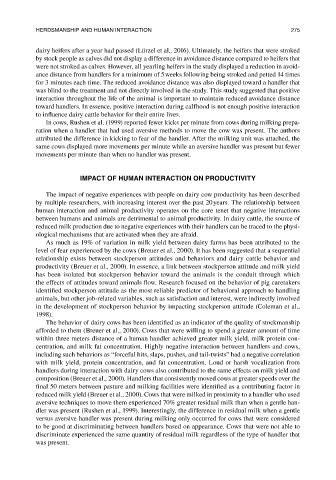Page 298 - The Welfare of Cattle
P. 298
herdsManshIP and huMan InteraCtIon 275
dairy heifers after a year had passed (Lürzel et al., 2016). Ultimately, the heifers that were stroked
by stock people as calves did not display a difference in avoidance distance compared to heifers that
were not stroked as calves. However, all yearling heifers in the study displayed a reduction in avoid-
ance distance from handlers for a minimum of 5 weeks following being stroked and petted 14 times
for 3 minutes each time. The reduced avoidance distance was also displayed toward a handler that
was blind to the treatment and not directly involved in the study. This study suggested that positive
interaction throughout the life of the animal is important to maintain reduced avoidance distance
toward handlers. In essence, positive interaction during calfhood is not enough positive interaction
to influence dairy cattle behavior for their entire lives.
In cows, Rushen et al. (1999) reported fewer kicks per minute from cows during milking prepa-
ration when a handler that had used aversive methods to move the cow was present. The authors
attributed the difference in kicking to fear of the handler. After the milking unit was attached, the
same cows displayed more movements per minute while an aversive handler was present but fewer
movements per minute than when no handler was present.
IMPaCt OF hUMaN INteraCtION ON PrODUCtIVItY
The impact of negative experiences with people on dairy cow productivity has been described
by multiple researchers, with increasing interest over the past 20 years. The relationship between
human interaction and animal productivity operates on the core tenet that negative interactions
between humans and animals are detrimental to animal productivity. In dairy cattle, the source of
reduced milk production due to negative experiences with their handlers can be traced to the physi-
ological mechanisms that are activated when they are afraid.
As much as 19% of variation in milk yield between dairy farms has been attributed to the
level of fear experienced by the cows (Breuer et al., 2000). It has been suggested that a sequential
relationship exists between stockperson attitudes and behaviors and dairy cattle behavior and
productivity (Breuer et al., 2000). In essence, a link between stockperson attitude and milk yield
has been isolated but stockperson behavior toward the animals is the conduit through which
the effects of attitudes toward animals flow. Research focused on the behavior of pig caretakers
identified stockperson attitude as the most reliable predictor of behavioral approach to handling
animals, but other job-related variables, such as satisfaction and interest, were indirectly involved
in the development of stockperson behavior by impacting stockperson attitude (Coleman et al.,
1998).
The behavior of dairy cows has been identified as an indicator of the quality of stockmanship
afforded to them (Breuer et al., 2000). Cows that were willing to spend a greater amount of time
within three meters distance of a human handler achieved greater milk yield, milk protein con-
centration, and milk fat concentration. Highly negative interaction between handlers and cows,
including such behaviors as “forceful hits, slaps, pushes, and tail-twists” had a negative correlation
with milk yield, protein concentration, and fat concentration. Loud or harsh vocalization from
handlers during interaction with dairy cows also contributed to the same effects on milk yield and
composition (Breuer et al., 2000). Handlers that consistently moved cows at greater speeds over the
final 50 meters between pasture and milking facilities were identified as a contributing factor in
reduced milk yield (Breuer et al., 2000). Cows that were milked in proximity to a handler who used
aversive techniques to move them experienced 70% greater residual milk than when a gentle han-
dler was present (Rushen et al., 1999). Interestingly, the difference in residual milk when a gentle
versus aversive handler was present during milking only occurred for cows that were considered
to be good at discriminating between handlers based on appearance. Cows that were not able to
discriminate experienced the same quantity of residual milk regardless of the type of handler that
was present.

